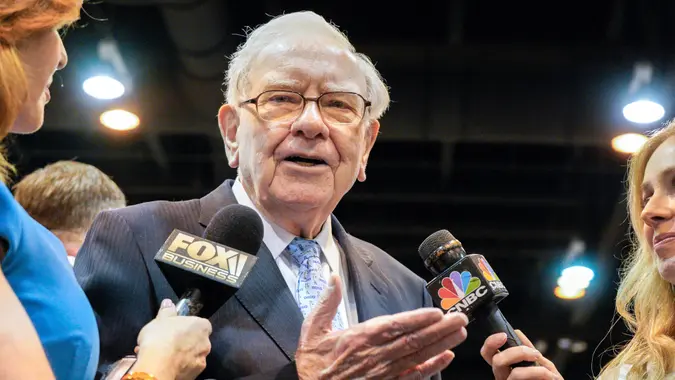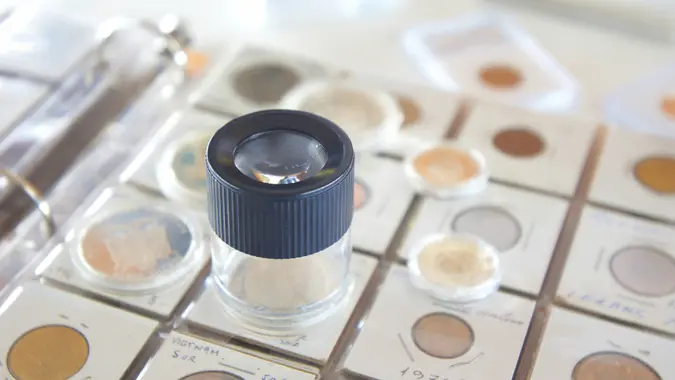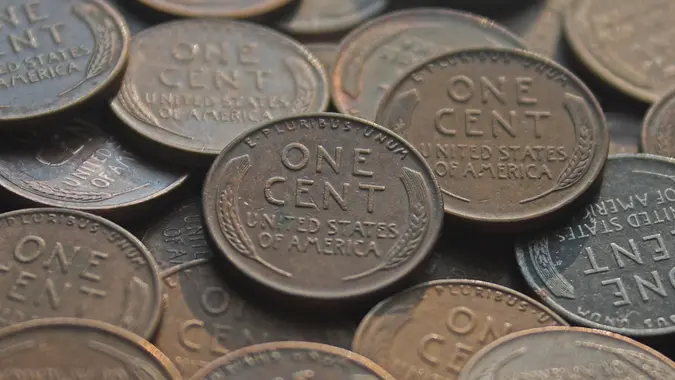Advertiser Disclosure
GOBankingRates works with many financial advertisers to showcase their products and services to our audiences. These brands compensate us to advertise their products in ads across our site. This compensation may impact how and where products appear on this site. We are not a comparison-tool and these offers do not represent all available deposit, investment, loan or credit products.
9 Money Moves To Make Now — If You Have $1,000 in Your Account
 Written by
Nicole Spector
Written by
Nicole Spector

Commitment to Our Readers
GOBankingRates' editorial team is committed to bringing you unbiased reviews and information. We use data-driven methodologies to evaluate financial products and services - our reviews and ratings are not influenced by advertisers. You can read more about our editorial guidelines and our products and services review methodology.

20 YearsHelping You Live Richer

Reviewed by Experts

Trusted by Millions of Readers
With the economy still scorched by the pandemic and lower-income groups feeling the brunt of the burn, the prospect of having money to spare could sound like something out of a fairytale. But let’s suppose you do come into some extra cash. Not enough to say, buy a house or pay for college, but enough to make an immediate difference — like $1,000. What would be the best way to put that amount of money to good use?
Financial experts will surely advise you to not treat this “excess” cash as an excuse to go spend. “If you find yourself with an extra $1,000, don’t consider it ‘extra’ and be frivolous with it,” said Michael Foguth, founder of Foguth Financial Group. “This $1,000 can be used in a variety of ways to help you attain your financial goals.”
Money experts will also likely urge you to put the $1,000 toward paying down debt to “prevent those high-interest payments from cascading out of control,” said Daniel Hampel, director of operations at PARCO.
But paying off debt isn’t the only intelligent move you can make should you find yourself graced with a spare grand. Read on to learn about other savvy maneuvers financial experts recommend to get the biggest bang out of $1,000.
Last updated: Aug. 17, 2021
Start an Emergency Fund
If you’re not going with Hampel’s advice of paying down debt but still want to do something useful like Foguth advised, an emergency fund could be the right way to go.
“Keeping money set aside in a bank account may not be the most exciting thing you can do, but it is one of the most important,” said Matt Hylland, financial planner at Arnold and Mote Wealth Management.
“If 2020 has taught us anything, it is to expect the unexpected. Starting an emergency fund can help you be prepared for unplanned expenses or loss of income that would otherwise have thrown a wrench in your financial plan. Use a separate savings account at your bank or look into a money market account, but don’t worry too much about funding the highest yield right now. The primary value of the emergency fund is not earning interest, it is helping you sleep better knowing you have a safety net and helping you avoid high-interest debt, like personal loans or credit cards, when the unexpected occurs.”
Open a High-Yield Savings Account
If you’re starting an emergency fund, consider placing your money in a high-yield savings account.
“High-yield savings accounts are a great, low-risk option to receive interest on your money while still having access to it in case of emergency,” said Chris Holder, financial advisor, CEO and founder of $100 Million Run. “I recommend shopping around to see which banks are offering the highest interest rates — Barclays, Goldman Sachs, HSBC and American Express all offer high-yield accounts. The difference between a regular savings account and a high-yield account does not typically have withdrawal locations — everything is done electronically. There is normally no minimum balance and no fees. Rather than earning a minimum interest from sitting in a regular savings account, a high-yield account can accrue interest rates up to 2.25%.”
Make Necessary Repairs
If you don’t have any debts to pay off and you have an emergency fund in place, take a look around your home (or car) and consider what you’ve been putting off upgrading or replacing.
“If you’ve been putting off necessary repairs, now could be a great time to make them,” Hampel said. “For some, this might mean fixing leaky insulation. For others this could mean getting a much-needed set of new tires on your car. Whatever it is, these preventative maintenance activities can save you a lot of money down the road. In reference to the old adage, ‘a stitch in time saves nine,’ making necessary repairs, such as replacing old tires, could prevent an accident in wintertime and will improve your fuel economy.”
Open a Roth IRA
Another smart move to make with $1,000 is to open a Roth IRA. Sammy Azzouz, CFP, president of Heritage Financial and author of The Boston Advisor blog reasons that this can simultaneously serve as a retirement savings kick-starter and emergency fund.
“The Roth IRA is a great retirement vehicle because its earnings grow tax free and you are never forced to make withdrawals from it,” Azzouz said. “However, if you run into an emergency and need cash before retirement, your contributions into the Roth IRA can be withdrawn tax and penalty free. The contribution limit is $6,000, or $7,000 if you’re 50 or over.”
Double Your Money With 401(k) Employer Matching
“If you haven’t maxed out your yearly employer benefit, put your $1,000 contribution into your 401(k),” Holder said. “Most employers match between .50 cents to a full dollar, therefore, you could easily turn your $1,000 to $1,500 to $2,000.”
Start an Online Business
“Any financial advisor will tell you, second streams of income are the best way to work toward six- and seven-figure goals,” Holder said. “Start by using your money to set up an online side hustle or LLC. A few examples: Affiliate marketing programs are a great option, as well as offering content creation and social media management. Put down a small deposit for your business bank account, website and even get some professional photos to get you going.”
Go In on the Stock Market
Financial advisors generally do not advise playing the stock market with $1,000 if you’re low on savings or don’t have a cushy retirement plan in action. But if you’re really looking to get in on the Wall Street action, consider an exchange-traded fund (ETF).
“Putting your money into an ETF (basically a basket of securities in one fund versus one stock by itself) that follows the S&P 500 as the long-term historic percentages show may only have a small short-term ROI, but is a great long-term investment,” Holder said.
Hire a Financial Coach
“Even the best of the best know that they need someone to give them wisdom, observe and change their behaviors and hold them accountable,” said Jeremy Keil, CFP, CFA, a retirement-focused financial planner with Keil Financial Partners and host of the Retirement Revealed blog and podcast.
“You don’t necessarily have the time to learn all there is to know about finances; it’s hard to critique or even see your own financial mistakes and it helps to have someone keep you on track toward the goals you create for yourself. Investing in a financial coach can pay off in less stress, and hopefully even more money.”
Share this article:




You May Also Like


If You Earn $100K a Year, Here's Where You Actually Rank Among All Americans
December 02, 2025
7 min Read


If the Top 10 Billionaires' Wealth Was Distributed Equally in America, How Much Money Would Each Person Get?
December 03, 2025
7 min Read

22 States in or Near a Recession Right Now -- and What It Means for Residents
December 03, 2025
7 min Read

5 Key Signs You've Been Hacked -- and What To Do Next To Protect Your Money
December 03, 2025
7 min Read

These 6 Career Skills Increase Your Chances of Earning More Money, According to Experts
December 03, 2025
7 min Read

4 Mistakes To Avoid If You Find an Old Coin or Bill That Could Be Valuable
December 03, 2025
7 min Read




Make your money work for you
Get the latest news on investing, money, and more with our free newsletter.
By subscribing, you agree to our Terms of Use and Privacy Policy. Unsubscribe at any time.


Thanks!
You're now subscribed to our newsletter.
Check your inbox for more details.



Sending you timely financial stories that you can bank on.
Sign up for our daily newsletter for the latest financial news and trending topics.
For our full Privacy Policy, click here.
Looks like you're using an adblocker
Please disable your adblocker to enjoy the optimal web experience and access the quality content you appreciate from GOBankingRates.
- AdBlock / uBlock / Brave
- Click the ad blocker extension icon to the right of the address bar
- Disable on this site
- Refresh the page
- Firefox / Edge / DuckDuckGo
- Click on the icon to the left of the address bar
- Disable Tracking Protection
- Refresh the page
- Ghostery
- Click the blue ghost icon to the right of the address bar
- Disable Ad-Blocking, Anti-Tracking, and Never-Consent
- Refresh the page






